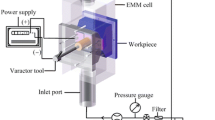Abstract
Scanning electrochemical microscopy (SECM) has already been employed as a micromachining method for a long time. However, coupling effects of some factors, including the voltage of the tool electrode, the distance between the tool electrode and substrates, tip current, and machining time on the machining process, have not been clearly stated. In this study, based on simulation and experimental results, an etching function between the etching depth and the above influencing factors in the machining process with SECM is proposed. First, the influence of the tool electrode, the distance between the tool electrode and substrates, tip current, and machining time on the etching depth was analyzed by a two-dimensional (2D) axisymmetric finite element model. Second, the etching function between these factors and the etching depth was established. Finally, this relationship was then simplified and verified by etching experiments. In summary, the etching function can be used to guide the etching process to machine 2D and 3D microstructures with SECM.




Similar content being viewed by others
References
Bard AJ, Fan FRF, Kwak J, Lev O (1989) Scanning electrochemical microscopy. Introduction and principles. Anal Chem 61(2):132–138
Ventosa E, Schuhmann W (2015) Scanning electrochemical microscopy of Li-ion batteries. Phys Chem Chem Phys 17(43):28441–28450
Mirkin MV, Nogala W, Velmurugan J, Wang YX (2011) Scanning electrochemical microscopy in the 21st century. Update 1: five years after. Phys Chem Chem Phys 13(48):21196–21212
Kai T, Zoski CG, Bard A (2018) Scanning electrochemical microscopy at the nanometer level. Chem Commun 54:1934–1947
Polcari D, Dauphin-Ducharme P, Mauzeroll J (2016) Scanning electrochemical microscopy: a comprehensive review of experimental parameters from 1989 to 2015. Chem Rev 116(22):13234–13278
Izquierdo J, Knittel P, Kranz C (2018) Scanning electrochemical microscopy: an analytical perspective. Anal Bioanal Chem 410(2):307–324
Mandler D, Bard AJ (1990) Hole injection and etching studies of gallium arsenide using the scanning electrochemical microscope. Langmuir 6(9):1489–1494
Mirkin MV, Horrocks BR (2000) Electroanalytical measurements using the scanning electrochemical microscope. Anal Chim Acta 406(2):119–146
Zheng Q, Huang X, Liu Y, Fang X, Zhang J, Shao H (2017) Electrochemical quantification of intermolecular hydrogen bonding between ferrocenemethanol and 3-mercaptopropanoic acid on gold. J Phys Chem C 121(40):22123–22129
Zheng Q, Zhang J, Yang Y, Wang X, Ding K, Shao H (2017) Regulating the intermolecular hydrogen bonding: the reversible assembly and disassembly in the diffusion layer. J Electrochem Soc 164(2):H97–H103
Zhang J, Lai J, Wang W, Huang P, Jia JC, Han L et al (2017) Etching kinetics of III–V semiconductors coupled with surface passivation investigated by scanning electrochemical microscopy. J Phys Chem C 121(18):9944–9952
Shuming Y, Linlin Y, Guofeng Z, Tong W, Xiaokai Y (2018) Modeling and calibration of the galvanometric laser scanning three-dimensional measurement system. Nanomanuf Metrol 1(3):180–192
Michihata M, Kim J, Takahashi S, Takamasu K, Mizutani Y, Takaya Y (2018) Surface imaging technique by an optically trapped microsphere in air condition. Nanomanuf Metrol 1(1):32–38
Shimizu Y, Matsuno Y, Chen YL, Matsukuma H, Gao W (2018) Design and testing of a micro-thermal sensor probe for nondestructive detection of defects on a flat surface. Nanomanuf Metrol 1(1):45–57
Mirkin MV, Bard AJ (1992) Multidimensional integral equations: a new approach to solving microelectrode diffusion problems: part 2. Applications to microband electrodes and the scanning electrochemical microscope. J Electroanal Chem 323(1–2):29–51
Bard AJ, Mirkin MV, Unwin PR, Wipf DO (1992) Scanning electrochemical microscopy. 12. Theory and experiment of the feedback mode with finite heterogeneous electron-transfer kinetics and arbitrary substrate size. J Phys Chem 96(4):1861–1868
And YS, Mirkin MV, Fish G, Kokotov S, Daniel Palanker A, Lewis A (1997) Nanometer-sized electrochemical sensors. Anal Chem 69(8):1627–1634
Klusmann E, Schultze JW (1997) Ph-microscopy—theoretical and experimental investigations. Electrochim Acta 42(20):3123–3134
Zheng Q, Wei GW (2011) Poisson–Boltzmann–Nernst–Planck model. J Chem Phys 134(19):194101
Lianhuan H, Xuesen Z, Zhenjiang H (2017) Tip current/positioning close-loop mode of scanning electrochemical microscopy for electrochemical micromachining. Electrochem Commun 82:117–120
Zhang J, Jia J, Han L, Yuan Y, Tian ZQ, Tian ZW (2014) Kinetic investigation on the confined etching system of n-type gallium arsenide by scanning electrochemical microscopy. J Phys Chem C 118(32):18604–18611
Yuan Y, Han L, Huang D (2015) Electrochemical micromachining under mechanical motion mode. Electrochim Acta 183:3–7
Acknowledgements
The authors gratefully acknowledge financial support from the National Natural Science Foundation of China (21827802, 21573054, 21327002) and the Fundamental Research Funds for the Central Universities (20720190023).
Author information
Authors and Affiliations
Corresponding author
Ethics declarations
Conflict of interest
All authors declare that they have no conflicts of interest.
Rights and permissions
About this article
Cite this article
Wang, X., Han, L., Geng, Y. et al. The Simulation and Research of Etching Function Based on Scanning Electrochemical Microscopy. Nanomanuf Metrol 2, 160–167 (2019). https://doi.org/10.1007/s41871-019-00047-1
Received:
Revised:
Accepted:
Published:
Issue Date:
DOI: https://doi.org/10.1007/s41871-019-00047-1




